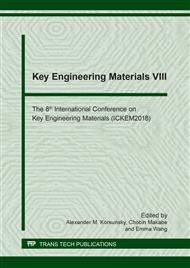p.74
p.81
p.89
p.94
p.99
p.109
p.115
p.120
p.127
Behaviour of CO2-Polypropylene at Different Temperature Using Molecular Modelling Technique
Abstract:
Polypropylene is one of the most widely used plastics due to its desirable qualities such as low cost and its versatility. Polypropylene is also a semi-crystalline polymer where its properties and behaviour are affected by the thermal/mechanical properties during processing. The objective of this work is to predict the behaviour of CO2-polypropylene system at different temperature using dynamic simulation technique. Molecular modelling method has been extensively used by process simulators to forecast the expected outcome of certain processes. Cell containing CO2 and polypropylene were built using Amorphous Cell module and dynamic simulation was conducted using Forcite module with COMPASS II forcefield at 150, 155, 158 and 160°C using NVT ensemble. Molecular structuring was observed for the polypropylene after dynamic simulation where it formed a spherical shape. From the analysis, the mean square displacement (MSD) for the CO2 was the highest at 160°C. Higher MSD for CO2 in the system means that it is easier for the molecules to move into the system. The predicted diffusion coefficient CO2 also follows the trend of the MSD graph where it increases when the temperature increases. Higher temperature means that more energy was supplied to the system which made the molecules become kinetically energetic. Hence, the CO2 molecules tended to move to a wider area compared to the system with low temperature. Based on the result presented in this paper, it was concluded that molecular modelling was able to predict the behaviour of polypropylene in the presence of CO2 at various temperatures.
Info:
Periodical:
Pages:
99-105
Citation:
Online since:
August 2018
Price:
Сopyright:
© 2018 Trans Tech Publications Ltd. All Rights Reserved
Share:
Citation:


